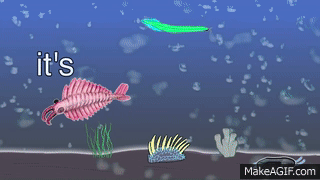IT'S THE CAMBRIAN EXPLOSION!
We finally arrived on what could be considered one of the most exciting turns on a planet's history
Before we get to build our bestiary full of weird ancient creatures, we must recap what happened so far in this world's history.
Paart been through 3,8 billion years of history, from it's formation, to the formation of it's little moon Taaf (which we will present later), to the origin of life in it's early seas, to glaciations, to super continents, and in resume - for the last 350Myr, Paart's been a messy and stormy world, about 20Mya, the super continent of Sthalika began to break apart, and with it's opening seas, came new ways and new habitats for life to explore, without much competition in this promised land, life began to experiment with brand new and exotic forms and lifestyles, starting an explosion of diversity that would be forever recorded in the mud of flooding valleys in the new continents.
Here we see the last genus of Albazoa die out - with the further breaking of cold oceanic currents, while the more versatile and complex Metazoans thrive in the calm and warm waters left after the last hypercane dissipated...
At the time Sthalika split, Paart's crust was divided in 8 plates, 2 of which were entirely under the Pannotic Ocean, half the mountain ranges from the formation of Sthalika eroded away with the severe Proterozoic weather, the water - previously locked in the Great Northern Ice Cap flooded plains the size of countries creating the Northern Sea and the Voreal Sea, some lakes later joined to ocean to form a complex of mineral rich Mediterranean-like seas as the continents drifted away from each other (Each currently named after what it looks like, because other than that there is currently no great features to call them by).
As said before, the disruption of equatorial and southern oceanic currents crowned the extinction of Albazoa, the so called Pannotic Ocean now formed a Pacific-like system of currents, creating a water hemisphere with occasionally heavy tropical storms, part of why over time, the eastern part of Piscia is getting eroded away.
The high density of nutrients and minerals of the water coming off the new seas aided the formation of hard structures like shells, teeth and carapaces, giving rise to what could be classified as arthropods and mollusks mainly.
Here we see the last genus of Albazoa die out - with the further breaking of cold oceanic currents, while the more versatile and complex Metazoans thrive in the calm and warm waters left after the last hypercane dissipated...
Cambrian Paart, 3850Myo
At the time Sthalika split, Paart's crust was divided in 8 plates, 2 of which were entirely under the Pannotic Ocean, half the mountain ranges from the formation of Sthalika eroded away with the severe Proterozoic weather, the water - previously locked in the Great Northern Ice Cap flooded plains the size of countries creating the Northern Sea and the Voreal Sea, some lakes later joined to ocean to form a complex of mineral rich Mediterranean-like seas as the continents drifted away from each other (Each currently named after what it looks like, because other than that there is currently no great features to call them by).
As said before, the disruption of equatorial and southern oceanic currents crowned the extinction of Albazoa, the so called Pannotic Ocean now formed a Pacific-like system of currents, creating a water hemisphere with occasionally heavy tropical storms, part of why over time, the eastern part of Piscia is getting eroded away.
The high density of nutrients and minerals of the water coming off the new seas aided the formation of hard structures like shells, teeth and carapaces, giving rise to what could be classified as arthropods and mollusks mainly.
A shy general cladogram resuming the last 400 million years for life
Project Paart is an Open World now, so the next chapter in this world's history may take a while to come out
However, you can follow the discussion here
We hope to see you soon!
[Cambrian Fauna]
coming soon!
However, you can follow the discussion here
We hope to see you soon!
[Cambrian Fauna]
coming soon!
- M.O. Valent, 02/05/2020








No comments:
Post a Comment